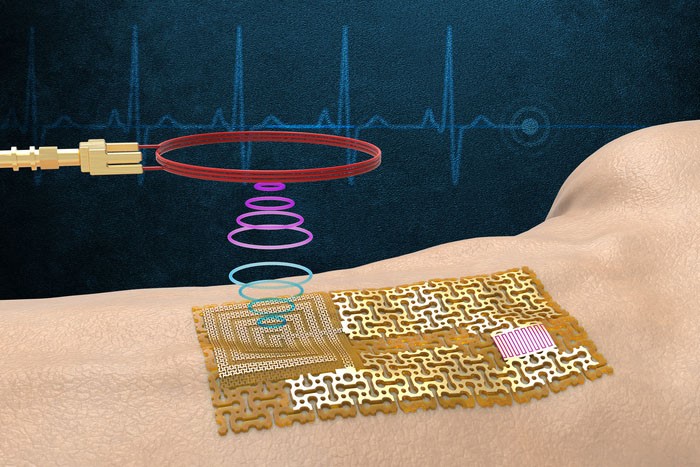Engineers fabricate a chip-free, wireless electronic 'skin'
Now MIT engineers have devised a new kind of wearable sensor that communicates wirelessly without requiring onboard chips or batteries. Their design, detailed today in the journal Science , opens a path toward chip-free wireless sensors. The heart of the sensor is an ultrathin, high-quality film of gallium nitride, a material that is known for its piezoelectric properties, meaning that it can both produce an electrical signal in response to mechanical strain and mechanically vibrate in response to an electrical impulse. The researchers found they could harness gallium nitride’s two-way piezoelectric properties and use the material simultaneously for both sensing and wireless communication.
In their new study, the team produced pure, single-crystalline samples of gallium nitride, which they paired with a conducting layer of gold to boost any incoming or outgoing electrical signal. They showed that the device was sensitive enough to vibrate in response to a person’s heartbeat, as well as the salt in their sweat, and that the material’s vibrations generated an electrical signal that could be read by a nearby receiver. «You could put it on your body like a bandage, and paired with a wireless reader on your cellphone, you could wirelessly monitor your pulse, sweat, and other biological signals».
Pure resonance
In their new study, the engineers used the same technique to peel away ultrathin single-crystalline films of gallium nitride, which in its pure, defect-free form is a highly sensitive piezoelectric material. The team looked to use a pure film of gallium nitride as both a sensor and a wireless communicator of surface acoustic waves, which are essentially vibrations across the films. The researchers hypothesized that a gallium nitride-based sensor, adhered to the skin, would have its own inherent, «resonant» vibration or frequency that the piezoelectric material would simultaneously convert into an electrical signal, the frequency of which a wireless receiver could register. «If there is any change in the pulse, or chemicals in sweat, or even ultraviolet exposure to skin, all of this activity can change the pattern of surface acoustic waves on the gallium nitride film,» notes Yeongin Kim.
Wave transmission
To test their idea, the researchers produced a thin film of pure, high-quality gallium nitride and paired it with a layer of gold to boost the electrical signal. They placed the new e-skin on volunteers’ wrists and necks, and used a simple antenna, held nearby, to wirelessly register the device’s frequency without physically contacting the sensor itself. The device was able to sense and wirelessly transmit changes in the surface acoustic waves of the gallium nitride on volunteers’ skin related to their heart rate. With this enhancement, the device could sense and wireless transmit changing sodium levels as a volunteer held onto a heat pad and began to sweat.
The researchers see their results as a first step toward chip-free wireless sensors, and they envision that the current device could be paired with other selective membranes to monitor other vital biomarkers.
Source: https://www.nanowerk.com/nanotechnology-news2/newsid=61303.php
Date: Aug 18, 2022

